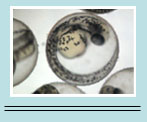

Home
Common Techniques
Classroom Experiments
Virtual Experiments
Tutorials
Games
Glossary
Links
Publishing
Opportunities
About This Site
Contact Us
ZFIN
Cite Us
Lithium Treatment to Disrupt Wnt Signaling
Download the pre-lab worksheet
Background Information
Wnt proteins are used extensively during embryonic development, cancer development, and, to some extent, day-to-day adult organismal life. The name “Wnt” is derived from the gene “wingless” (Wg) found in Drosophila and the gene INT, which functions homologously as the Wg gene due to its evolutionary similarity in amino acid sequence. The two proteins resulting from these genes came to be part of the large Wnt family of proteins.
Wnt proteins function extracellularly in cell-cell communication. When one cell is induced to produce the Wnt signal, it secretes Wnt proteins into the extracellular space. As a result, the Wnt proteins can induce signal transduction cascades in the surrounding cells as well as the cell of origin.
The number of possible signal transduction pathways is rather extensive, but one important pathway includes the inhibition of the enzyme GSK-3 (glycogen synthase kinase 3). This signal transduction helps create the dorsal-vental axis during development. Lithium can also inhibit GSK-3. GSK-3 inhibits glycogen synthase and helps control the cell after DNA damage by phosphorylating certain enzymes or substrates. In zebrafish, Wnt and GSK-3 is important in dorsal-ventral axis formation and heart development, including placement and left-right asymmetry.
Gilbert, S. Developmental Biology, 9th Edition.
In this lab, students will use lithium chloride (LiCl) to mock Wnt GSK-3 inhibition in zebrafish embryos. LiCl is used because it is a salt, which is easy to handle, and has a low level of toxicity if not ingested. The presence of LiCl will disrupt normal Wnt signaling early in development so that students can see how a developing embryo is affected by the absence of typical Wnt signaling.
Instructor Information
This experiment is suited for students who have a general knowledge of zebrafish development, including signal transduction pathways and organogenesis (specifically cardiogenesis). However, the expertise needed, both in knowledge and in laboratory skill, is minimal. Therefore, this experiment Would be most stuitable for use in introductory developmental biology courses. Students may work in groups or independently depending on materials available. Any size class may use this lab due to its small demand of materials.
Materials Needed
- Petri dishes
- Netwell baskets
- Living zebrafish embryos at cleavage and late blastula stages
- E3 medium (5 mM NaCl, 0.17mM KCl, 0.33 mM CaCl2, 0.33 mM MgSO4, and 0.1% Methylene Blue)
- 0.3 M LiCl in E3
- Pipets
- Embryo loops
- Fine forceps
- Timers or stopwatches
- Slides
- Methylcellulose
- Fish water
- Dissecting stereomicroscopes
Techniques Used
- Pipetting embryos
- Dechorionation
- Using a dissecting stereomicroscope
- Mounting embryos in methylcellulose
- Creating and using embryo loops (if not already made)
